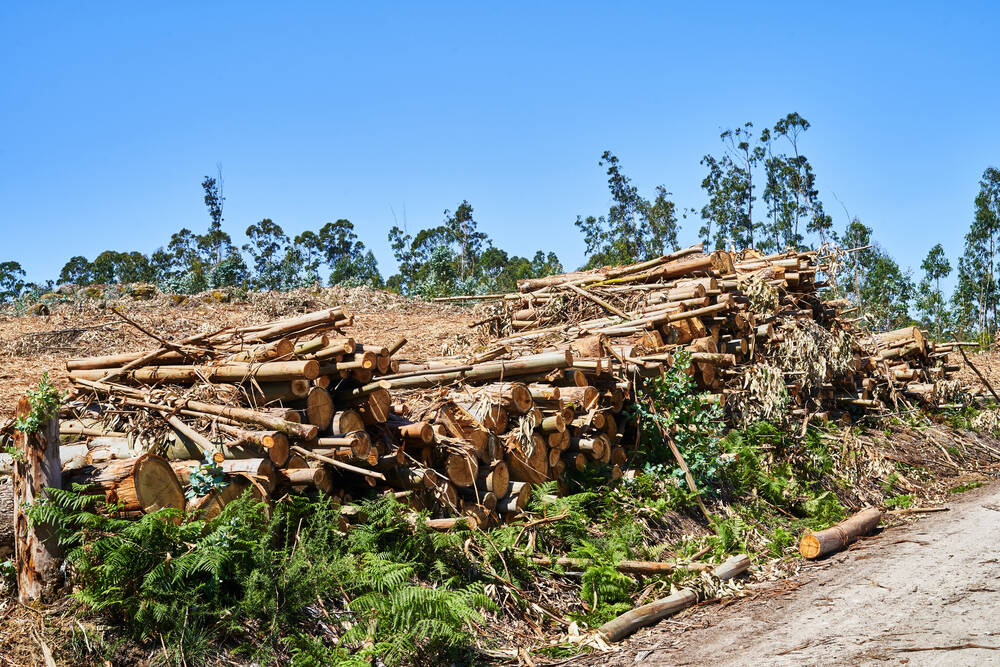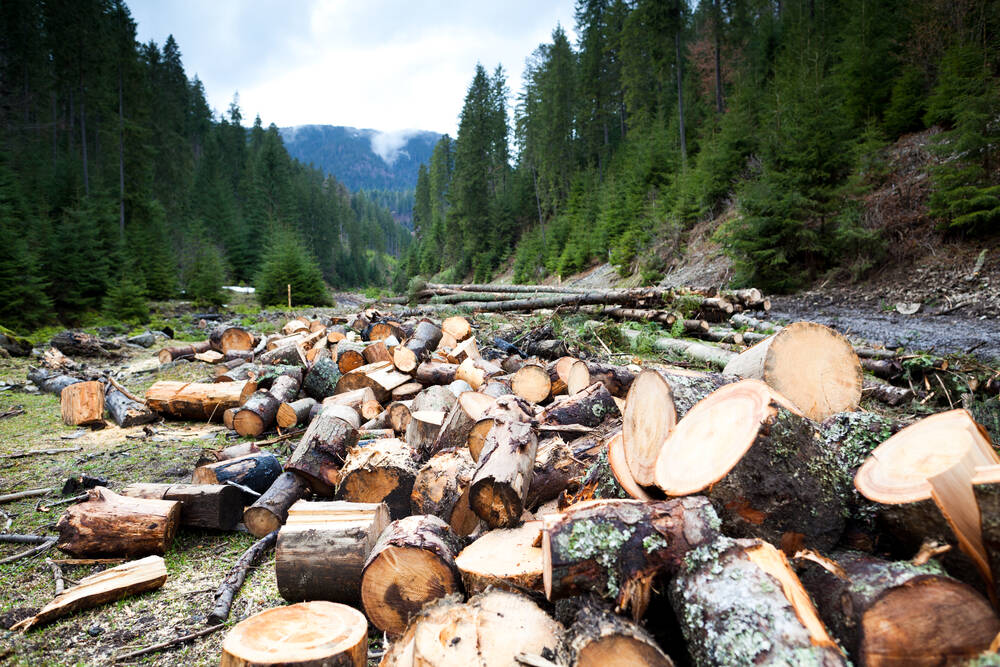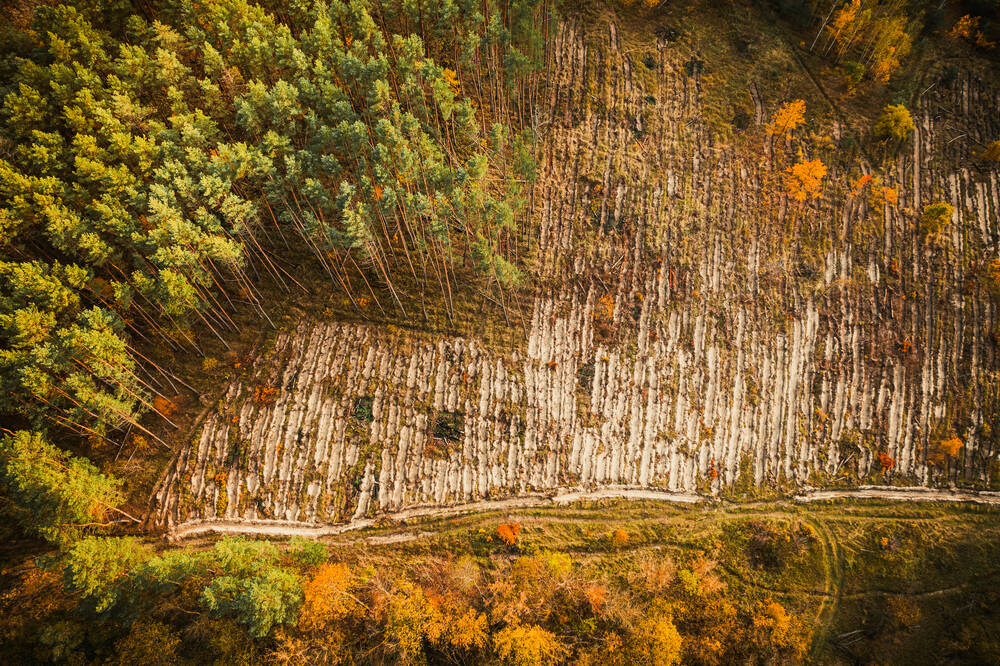Deforestation is accelerating across the globe, driven by human activity and unsustainable practices. This environmental crisis is fuelled by timber extraction, wood harvesting, large-scale agriculture, soy farming, crop farming, livestock farming, and illegal logging.
As farmers clear land for profit, trees are cut down at alarming rates, causing forest loss, loss of biodiversity, and soil erosion. The global demand for palm oil, paper products, and land for road building intensifies land use change.
This results in increased carbon dioxide in the atmosphere, worsening the impact on the climate, and placing immense pressure on the Amazon rainforest and other tropical forests.
What is Deforestation?
Deforestation is when trees and forests are cut down at a small or large scale for the purposes of agriculture, logging, urbanisation, infrastructure development, resource extraction or other needs. It’s globally recognised as extremely harmful to the environment, as well as displacing indigenous communities and robbing the livelihoods of forest-dependent people.
Forests, woods and trees are some of the strongest carbon dioxide sinks on the planet, and wiping them out causes a huge increase in CO2 levels, enhancing global warming and disruptions in weather patterns. Deforestation obstructs water cycles, leading to further unseen weather changes.
Reforestation is a mitigation strategy, but at times cannot compete. Sustainable forestry practices and conservation programs have administered widespread global efforts to combat deforestation and aid the environment.

Hydroelectric Projects
Hydropower is when electricity is generated using water such as river systems and dams. The currents of the water turn turbines linked to generators, hence the water’s kinetic energy turns into mechanical energy.
In the UK, they are predominantly used in Scotland as its high rainfall and rugged terrain create ideal conditions for dam creation and water storage. Using water, it’s a renewable source (to an extent).
It works by building a big dam to block a river, creating a huge reservoir, putting lots of pressure behind the dam wall, which builds up, then releasing it all through turbines to create electricity.
An effective method, it’s also effective at wiping out entire forests. Some of these dams are as big as entire towns, and upon releasing the water, vast areas of forest are permanently flooded and lost.
Unfortunately, the workarounds generate significantly less amounts of electricity than the incredibly harmful method.
Beyond wiping out forests, large-scale hydropower projects kill masses of animals—terrestrial sloths, birds, insects, and entire aquatic ecosystems. A tragic example is the Balbina Dam in Brazil, which flooded over 2,400 km² of rainforest and caused catastrophic biodiversity loss.
While the benefits of electricity are often highlighted, ecological devastation is rarely acknowledged. These projects release vast volumes of water—sometimes the size of towns—within minutes, drowning habitats and displacing countless species.
Tragically, money talks louder than morality. What’s sold publicly as “clean energy” can actually be a cruel, harmful, and evil practice.
Palm Oil Plantations
Palm oil production is one of the leading drivers of deforestation in the world. It’s hidden in the majority of everyday products such as makeup, skincare, shower products, washing powder, and soaps. You likely eat it in biscuits, cakes, spreads, crisps, instant noodles, as well as ice cream.
Beyond most of your cupboard(s), its by-products have likely been fed to the animals you eat, and are maybe even in the car you drive if you’ve swapped to biodiesel to be more “green” conscious.
This narrative alone highlights the importance of supply chain transparency. One thing is fixed, while three things are compromised. In this case, consumers feel proud to drive green biodiesel, but aren’t realising the burnt forest and dead wildlife it came from.
Until a company can prove its supply chain is deforestation-free and ethically sound from start to finish, anything could be hidden away—from habitat destruction to human rights abuse. Marketing is a clever thing.
Palm oil trees favour humid and temperate climates, making rainforests in Southeast Asia prime targets. Once beautiful biodiverse forests like the Leuser Ecosystem in Indonesia have since been cleared out to make room for these plantations.
This can involve unsustainable methods such as slash-and-burn, causing further ecological devastation. Existing rainforests are cleared more than using empty land, as sourcing degraded land isn’t as quick as the short-term method—plus the cleared timber dually maximises your profits.
But palm tree plantations result in forests again, right? While the original rainforest could host upwards of 300 species per hectare, these stricken, homogenous, and monocultural “forests” are ecological dead zones by comparison, with maybe the rare rat, snake or adapted bird wandering through.
Agriculture Expansion
Deforestation is widely driven by agricultural expansion, with demands for food and biofuels increasing as biodiversity levels decline and dependences on finite sources are depleting. Forests are cleared to make room for cropland for agricultural purposes, including large-scale monoculture plantations that offer short-term yield but long-term ecological damage.
Agriculture is one of the main causes of forest conversion in the Amazon. This causes erosion in soil and river siltation, harmful to biodiversity and nature. The chemicals used for agriculture such as those in pesticides and fertilisers pollute water and degrade aquatic habitats, affecting both human communities and wildlife ecosystems.
Cattle Ranching
Cattle ranching—raising herds of cows for milk, meat, and other products—takes up a significant amount of grazing land.
Global demand for beef is increasing, with the UK less of a direct cause, however forests are still being impacted such as in the Amazon and parts of Africa.
In the Amazon Rainforest, cattle ranching accounts for around 80% of the cleared land. This typically involves powerful fires, destroying animals, plants, and habitats whole. They stop the fires by setting controlled burns to limit the spread, however the damage to the environment and biodiversity is already done.
This process remains illegal in many countries, and contributes largely to illegal deforestation without the use of a permit and breaking regulations. The repercussions for this can be severe fines and loss of land rights, however it continues because of lack of enforcement and high economic rewards for ranchers.
The continuous grazing degrades soil over time, with no tree roots keeping soils in place, leaving them vulnerable to external harm such as erosion or flooding. In the Amazon, the cows usually feed on native vegetation, which depletes nutrients and damages the soil structure.
Economic pressures in areas such as Brazil and Argentina can lead to a priority of ranching over conservation. This happens because the demand for beef means higher profits for local ranchers and agribusinesses. Immediate economic gain is favoured over long-term environmental sustainability.
Logging
Tree cutting and commercial logging are central to the global supply chain, particularly for paper production, which continues to rise with the global demand for paper products. This contributes significantly to deforestation for development, where farmers clearing land and industrial-scale logging operations accelerate global deforestation.
As millions of hectares of forest are lost, we see a marked loss of tropical forests and primary forests, which are irreplaceable in terms of biodiversity and climate regulation. These activities lead to disruption of water cycles, increased risk of flooding and drought, and a steep decline in indigenous land and cultures, amplifying the impact on the environment.

Urbanisation & Infrastructure
Forests can be partially cleared to make way for infrastructure development, such as roads or bridges that cross through the forest, creating habitat barriers for local wildlife.
Forests can be wiped out and entirely cleared to make space for large scale urban development and expansion, accommodating for the growth of cities, which further requires resources that could come from the forest such as timber.
This leads to tourism development, especially in areas with beautiful forests, resulting in increased infrastructure from hotels or resorts—heightening deforestation with resource demand cyclically rising.
This Catch-22 of urbanisation and increasing consumer demands worldwide are one of the primary drivers of deforestation. Cities expand and forests must be wiped out to make space for infrastructure development, resource extraction and habitats are lost.
Factories and industrial zones replace forests, at times taking our most powerful carbon sinks and climate-change mitigators and replacing them with pollution-powering hotbeds for global warming.
Populations increase in urban areas, leading to excess removal of forests to create housing, usually requiring more resources from forests to be used in construction. People abandon rural areas and intensify consumer demands in cities.
Mining
The majority of deforestation for mining is in pursuit of gold and coal, and across the globe are a heavy contributor to the problem. Accessing large mineral deposits can require large areas of land, removing tracts of forests, making room for processing plants, access roads, excavation pits, or waste disposal areas.
This pollutes the forest, such as dumping waste on the forest floor, harming the vegetation and habitat. The mining activities can further disturb the soil, eroding and degrading the land, in turn making it harder for the forests to regrow and regenerate.
As their excavations and successes develop, so does the land area, meaning more and more of the forest is wiped out as the natural resources are extracted.
Firewood & Charcoal Production
In developing countries such as India and Nigeria, firewood and charcoal are depended on largely for fuel for heating and cooking. This means that their production significantly drives deforestation, involving the wiping out of forests for fuelwood and charcoal production.
Not unusually, this process is unsustainable, meaning that replanting is not a regular occurrence. After forests are wiped out, especially in areas such as West Africa, what’s left behind is bare land and depleted soil and this land is then vulnerable to erosion. The degraded ecological balances lead to biodiversity loss, soil degradation, and increased greenhouse gas emissions.
Beyond cutting down trees on a major scale, charcoal is made from burning wood in a low-oxygen environment. To meet mass charcoal demand, this process is often unregulated and illegal, leading to unchecked deforestation.
As cities urbanise and develop, population growth and demand grow, meaning that charcoal and firewood are funded more and production speeds up. In the same vein as cattle ranching, economic pressures can cause an imbalance of priorities—choosing immediate economic gains in lieu of long-term environmental stability.
Charcoal and firewood use also has significant health implications. Indoor air pollution from burning these fuels contributes to respiratory illnesses, particularly among women and children spending time indoors.
As a result of the smoke, many people in developing countries suffer from chronic bronchitis, asthma, and other severe health problems. To combat this, clean cookstoves and alternative energy solutions are being promoted to reduce harmful emissions and improve air quality.
Fires
Another concerning driver of deforestation is fires. In areas where forests are prominent such as the Amazon, the rich biodiversity nature brings in eco-tourism, feeds the economy and leads to increased demand for land and resources.
In return, land use priorities shift—the need for forests is quickly overrun by the need for cattle ranching, agriculture, mining, and even urban development.
Popularly in tropical regions like Southeast Asia, a slash-and-burn technique is used, involving the cutting of vegetation and setting it alight. This is also mostly unsustainable, leaving land degraded and destroyed, with no strict replanting regulations in place in areas such as Indonesia.
The fires can easily spread beyond intended areas, with vast areas of forest destroyed at times. High winds, dry weather and combustible materials like leaves and dead wood lead to uncontrollable wildfires, and can be detrimental to wildlife, air quality, and long-term land productivity.
When fires hit biodiversity hotspots, entire habitats can be wiped out, including their inhabitants. I’ll spare the details of this tragic detriment, as they’re deeply upsetting, but the reality is mass loss of life—both animal and plant.
Beyond this, fires release massive amounts of carbon dioxide as trees burn, leaving land destroyed, and adding masses of harmful emissions into the atmosphere. The 2019 fires in the Amazon burned across tens of thousands of sites over several weeks. In August alone, they were estimated to have released over 200 million tonnes of CO₂.
Moreover, the fires add air pollution which affects local communities and even downwind countries, causing health complications, respiratory issues, and even school and work closures in severe cases.
Climate Change
Deforestation plays a major role in the contribution to climate change, as forests act as crucial carbon sinks. When they’re cleared, the stored carbon is released, accelerating global warming. The destruction of habitats also means countless species lose their homes, upsetting fragile ecosystems.
As millions of hectares of forest are lost, particularly primary forests, the effects are widespread: reduced air quality, reduced water quality, and an increased risk of drought due to disrupted rainfall patterns. Altogether, this significantly worsens the impact on the environment, making recovery harder and putting pressure on communities and biodiversity alike.
Rising temperatures and prolonged droughts made wildfires frequent and more severe. The droughts have a lasting impact on ecological conditions—trees weaken with less rainfall to nourish them, making them vulnerable to threats such as disease, pests, and early dieback.
Warmer, longer winters allow pests to thrive, such as bark beetles, which bore into and kill millions of trees, and are a significant problem in regions like Canada and the western United States.
Moreover, climate change has made storms more intense and frequent because of rising ocean temperatures and atmospheric instability. These can knock down entire trees, and change forest structures from dense, biodiverse canopies to sparse, fragmented woodlands.
Beyond this, some trees can’t keep up. Global warming is on a constant increase, and trees like the white spruce take up to 100 years to adapt to environmental changes such as a 1°C temperature increase in a decade. They’re having to adapt in a fraction of the time—leading to some tree species exhibiting stunted growth, reduced resilience, and ultimately dying off.
Land Conflicts & Encroachment
In some areas where land ownership laws are less stringent than protected conservation areas, such as parts of the Amazon Basin or Central Africa, land conflicts can actually lead to deforestation.
A land conflict is when more than one group claims rights to a bit of land—such as a forest or hillside. The land could be claimed by an Indigenous community, nomadic groups, small farmers, or unregistered residents. While there are governments, they could struggle with underfunding or even corruption from powerful industry lobbies or political interests.
When a company applies to use the land—i.e. for palm oil, mining, or cattle-ranching—a lack of documentation can mean that the company trumps the local or Indigenous claim, despite long-term historical or cultural links. Then the land is cleared and the damage is done.
In severe cases, the original residents can be threatened, such as forced evictions or legal intimidation, or attacked or murdered. In places like Brazil, the Philippines, and Honduras, murder over land conflicts happens frighteningly often.
Land permits and titles can occur in private, causing twisted deals that benefit corporations or political elites and can result in mass land loss, illegal deforestation, and irreversible damage to ecosystems.
While land conflict is top-down, encroachment is bottom-up. This is where smaller groups or individuals informally clear land, usually for survival, farming or to live there.
This tends to happen from displacement or poverty, driven by need less than greed.
Pests & Diseases
Pests and diseases cause deforestation as they can spread and wipe out millions of trees. Capable of much more than pesting; pests such as a bark beetle or emerald ash borer land on trees, bore into the bark and feed on the inner tissues, effectively cutting off the tree’s nutrient flow.
It could disease, lay eggs, and even come in a pack of a thousand at once, taking masses of forest at a time.
After this, trees can end up brittle, dry, and dead—perfect fuel for a wildfire to pick up and destroy permanently, or for loggers and developers to come in and finish the job. In most large outbreaks, there’s no cure beyond controlled burns, only adding to the problem at hand.
Pests and diseases are on the rise due to climate change. Habitats are fragmented, making it a lot easier for pests and diseases to spread because they travel quickly across disturbed landscapes, but harder for wildlife to move because they’re blocked by roads, fields, or settlements.
In warmer winters, pests like bark beetles survive longer, enjoying the lack of frost that would normally kill them off. Trees are already weakened from droughts, nutrient stress, and interrupted water cycles, making them more vulnerable than a healthy, well-rooted forest in balance would be.
With rising temperatures, pests move from warm, tropical or temperate regions into new ones. Where their original wildlife counterparts may have adapted resilience to them, new forests and tree species will likely be susceptible and suffer widespread die-offs.
More Information
https://www.europarl.europa.eu/RegData/etudes/BRIE/2020/652068/EPRS_BRI(2020)652068_EN.pdf

